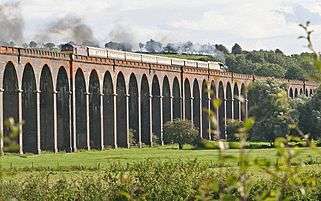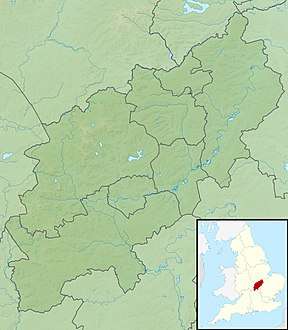Welland Viaduct
Welland Viaduct, Harringworth Viaduct or Seaton Viaduct,[3] crosses the valley of the River Welland between Harringworth in Northamptonshire and Seaton in Rutland, England.
Welland Viaduct | |
|---|---|
 | |
| Coordinates | 52°34′1″N 0°39′14″W |
| OS grid reference | |
| Carries | Oakham to Kettering Line |
| Crosses | River Welland |
| Locale | Northamptonshire – Rutland |
| Official name | Welland Viaduct |
| Maintained by | Network Rail |
| Heritage status | Grade II listed |
| Characteristics | |
| Total length | 1,275 yd (1.166 km) |
| Height | 60 ft (18 m) maximum |
| History | |
| Opened | 1880[1][2] |
 Welland Viaduct Location in England  Welland Viaduct Welland Viaduct (Northamptonshire)  Welland Viaduct Welland Viaduct (Rutland) | |
The viaduct is 1,275 yards (1.166 km) long and has 82 arches, each with a 40 feet (12 m) span. It is the longest masonry viaduct across a valley in the United Kingdom.[4] It was built by contractor Lucas and Aird and completed in 1878 and is now a Grade II listed building.[5]
The Welland Viaduct is on the Oakham to Kettering Line between Corby and Manton Junction, where it joins the Leicester to Peterborough line. The line is generally used by freight trains and steam specials. In early 2009, a single daily passenger service was introduced by East Midlands Trains between Melton Mowbray and St Pancras via Corby, the first regular passenger service to operate across the viaduct since the 1960s. The viaduct is on a diversionary route for East Midlands Railway using the Midland Main Line route. The viaduct is said to contain 30 million bricks.
History
Construction
In the late 1870s, the Midland Railway constructed the 17-mile line between Kettering in Northamptonshire and Manton, Rutland.[6] The valley of the River Welland required a long viaduct. In 1874, an Act of Parliament was passed, authorising the line's construction.[1] The contract for the viaduct was awarded to Lucas and Aird.[6]
The viaduct crosses the Welland Valley and its flood plain. It is 1,280 yards long (1,171 metres) and when built, only the elevated multi-track approach to London Bridge railway station was longer.[6][1] It was designed by William Henry Barlow and members of his company, including his son Crawford, who was the resident engineer, and his former pupil Charles Bernard Baker. Crawford described the Welland Viaduct as being: "one of the grandest and most perfect pieces of workmanship to be seen in the United Kingdom".[6]
In 1875, Cyprus Camp was built at the north end of the viaduct adjacent to the village of Seaton.[6] It had 47 wooden huts, each housing seven men, two women and three children.[6] Another 12 huts were built at Gretton Hill.[1]
The viaduct was built by manual labour.[6] It has been estimated that every man who prepared the ground and built the earthworks shovelled more than 20 tons of earth in a 12-hour shift. At its peak, a workforce of 3,500 and 120 horses, were employed along the length of the line.[6] Several workers died during its construction. An account of the workers, Life and Work Among the Navvies, was written by Reverend D. W. Barrett, the vicar of Nassington, curate-in-charge of the Bishop of Peterborough's railway mission.[1]
The viaduct required about 30 million bricks, most of which were fired onsite.[6] W. H. Lorden was the subcontractor for the brickwork and the bricks were produced by R. Holmes. Additional materials included 20,000 cubic yards (15,000 m3) of concrete and 19,000 cubic yards (15,000 m3) of stone.[1] Barrow lime for concrete and mortar was supplied by Ellis and Sons of Mountsorrel Junction, Leicester. The viaduct was built on land belonging to Lieutenant Colonel Tryon of Bulwick Hall.[1]
In March 1876, the first brick was laid and the first arch was completed in June 1877[7][1] and all 82 arches were constructed within 13 months.[6] On 5 July 1878, Lieutenant Colonel Tryon keyed the final arch in a ceremony to mark the viaduct's completion.[7]
Operations
Opened as a through passenger route on 1 March 1880, the Manton to Kettering line provided Nottingham with a more direct link to London with eight trains per day, four in each direction.[1] On 1 October 1885, the "Slip Coach", entered service to connect with fast trains to London, Northampton, Cambridge and the Eastern Counties at Kettering. By 1903, the line carried over a dozen express and stopping trains in both directions daily.[1]
In 1906, the embankment north of the viaduct collapsed because of insufficient drainage after heavy rain leaving the rails suspended in mid air.[8] During the First World War, the viaduct was attacked by a German Zeppelin, possibly because of its strategic importance in transporting troops to the ports on the English Channel.[9] In 1939, threats of bombing by the IRA resulted in the area around it being placed under guard.[10]
In 1967, as a consequence of the Beeching cuts, all passenger services over the viaduct were discontinued but the line remained open for freight traffic.[1]
The viaduct's brickwork has suffered from weathering and structural deterioration. Before the privatisation of British Rail, repairs were made by Kettering and Leicester civil engineering staff. Bricklayers reported seeing the imprints of children's hands and feet in the bricks from when they had walked on the clay-filled moulds before firing in the kiln. The viaduct is built from bricks manufactured onsite which have a red face. Repairs have used other types of bricks, predominantly blue engineering bricks, which have superior water resistance and are stronger, making them suited for arch re-lining and face brick replacement. The use of different bricks has given the viaduct a red-and-blue patchwork appearance.[6]
During 2004, in Network Rail's continuous structures maintenance programme, Birse Rail made structural repairs to the viaduct. The restoration cost £1.5m (equivalent to £2,320,000 in 2019).[11]. Traditional methods and materials were employed using modern access techniques to ensure the viaduct's long-term structural integrity.[12]
Between 2016 and 2017, works in Network Rail’s Infrastructure Projects East Midlands Civils Renewals was undertaken by Amco Rail.[6] It addressed brickwork defects and prepared the viaduct for a long-term strengthening scheme aimed at raising its restrictive load capacity rating from RA0 (the lowest rating) to RA10 (the highest rating) so that traffic can cross more quickly. Freight trains with a 25-tonne axle-load were limited to 20mph when crossing and the goal of the strengthening measures is to increase this to 60mph.[6][13]
The parapets had 20mm joints saw-cut through them to allow for sheer movement, reducing the rate of cracking, while over 2,300 20mm-diameter vertical reinforcement bars were installed at one-metre intervals through the brickwork to anchor the parapets to the structure. Vertical cracks were fitted with 6mm stitch bars where applicable, and galvanised steel angle brackets were fixed onto either side of joints where the outwards lean exceeded 40 mm.[6] Network Rail required that no further use be made of pattress plates on the viaduct. Core-drilling of the parapets was performed by a bespoke 900kg rig, developed by Amco Rail, which reduced the programme's cost by £200,000 over conventional means even when including its development cost.[6][13]

References
Citations
| Wikimedia Commons has media related to Welland Viaduct. |
- "The railway and viaduct". harringworthvillage.org. Retrieved 8 May 2018.
- Sources vary on the opening date; some claim that it opened during 1878, the same year as its completion.
- The name Seaton Viaduct is the official name of another smaller viaduct a mile further north, but the name is applied by local residents to Welland Viaduct, as evidenced in this historic postcard.
- Marshall, John. "The Guinness Book of Rail Facts & Feats". Guinness, 1979. ISBN 0-900424-56-7.
- Historic England. "Welland Viaduct (1264288)". National Heritage List for England. Retrieved 15 June 2015.
- "Harringworth Viaduct - Travel & Repeat." Rail Engineer, 1 August 2017.
- "Welland Viaduct". Leicester Journal. England. 2 August 1878. Retrieved 23 September 2017 – via British Newspaper Archive.
- "Landslide on the Midland". Morning Post. England. 8 December 1906. Retrieved 23 September 2017 – via British Newspaper Archive.
- "Zeppelin Attack, 1916." harringworthvillage.org, Retrieved: 8 May 2018.
- "Police Guard Viaduct". Grantham Journal. England. 29 July 1939. Retrieved 23 September 2017 – via British Newspaper Archive.
- UK Retail Price Index inflation figures are based on data from Clark, Gregory (2017). "The Annual RPI and Average Earnings for Britain, 1209 to Present (New Series)". MeasuringWorth. Retrieved 2 February 2020.
- "£1.5m project for historic viaduct". Northants Telegraph. England. 4 May 2004. Retrieved 26 September 2017.
- "Harringworth half-term report." Rail Engineer, 1 August 2016.
Bibliography
- Jack Simmons & Gordon Biddle (editors) (1997). "Entry for bridges and viaducts". The Oxford Companion to British Railway History. Oxford University Press. ISBN 0-19-211697-5.CS1 maint: extra text: authors list (link)
- Biddle, Gordon. Britain's Historic Railway Buildings: A Gazetteer of Structures (Second ed.). Hersham, Surrey: Ian Allan Publishing. ISBN 9780711034914.